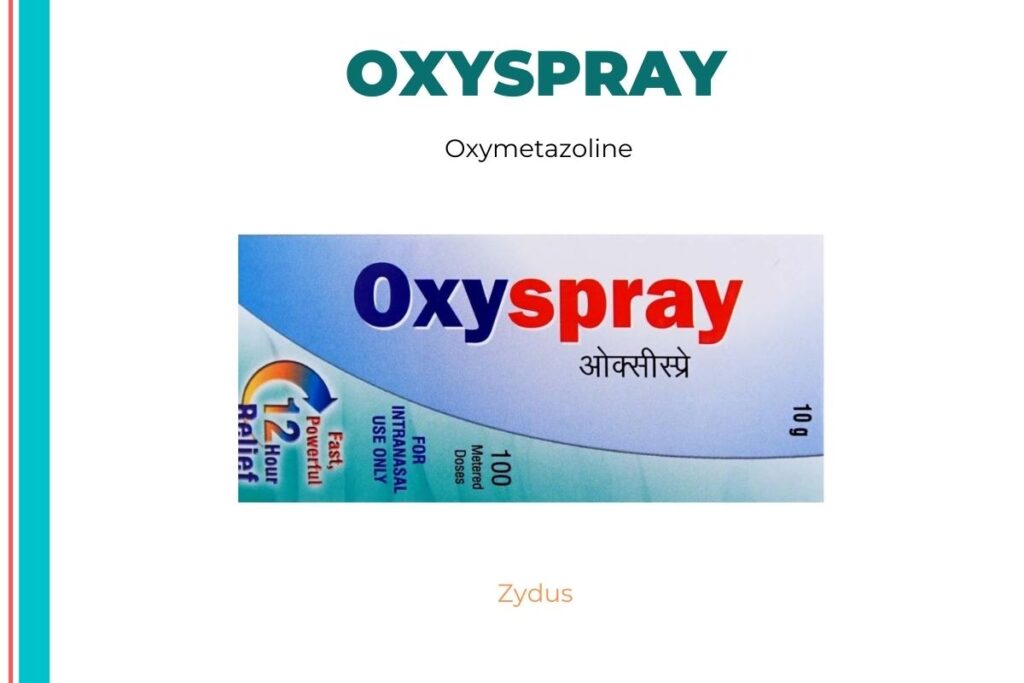Oxyspray Nasal Spray
Oxyspray Nasal Spray belongs to the ‘alpha1A adrenoceptor agonists’ class of medicines, which are used to alleviate nasal congestion. Oxyspray Nasal Spray is also effective in the treatment of rosacea and ptosis of the eyelid. Oxyspray Nasal Spray is used/indicated differently depending on the dosage form. For example, Oxyspray Nasal Spray nasal spray solution is used to treat nasal congestion, while Oxyspray Nasal Spray cream is used to treat rosacea-related facial redness (a skin disease that causes redness and pimples on the face).
Nasal congestion is an obstruction of the nasal passage caused by nasal fluid that has become suffocated. The abnormal drooping of the upper eyelid is known as ptosis. Rosacea is a skin ailment marked by tiny reddish-purple lumps on the face that are pus-filled.
The active ingredient in Oxyspray Nasal Spray is oxymetazoline, which belongs to the class of ‘alpha1A adrenoceptor agonists.’ It constricts blood vessels, limiting blood supply to swollen tissue in the nose, eyelids, and skin. This impact aids in the reduction of inflammation and the relief of symptoms.
Nasal spray, topical cream, and eye drop dose formulations are all available for Oxyspray Nasal Spray. It is not recommended to use it for longer than 7 days. Irritation or burning feeling at the point of administration, blurred vision, eye pain, sleepiness, dizziness, headache, and slow or fast heartbeat are all common adverse effects of Oxyspray Nasal Spray. Consult your doctor right away if you notice that these side effects do not go away or get worse.
If you are allergic to oxymetazoline or any of the other substances in Oxyspray Nasal Spray, do not use it. If you are pregnant or nursing, or if you have heart disease, brain disease, high or low blood pressure, diabetes, Sjogren’s syndrome (an immune system issue), or vision difficulties, tell your doctor (glaucoma). If you are on or have recently taken monoamine oxidase inhibitors (for depression), do not take this medicine. If you are pregnant or breastfeeding, tell your doctor.
Oxyspray’s Applications Spray for the nose
Nasal congestion, eyelid ptosis, and rosacea are all symptoms of rosacea.

Medicinal Advantages
The active ingredient of Oxyspray Nasal Spray is oxymetazoline, a decongestant. It constricts blood vessels, limiting blood supply to swollen tissue in the nose, eye, or skin. This has the effect of reducing inflammation and so easing symptoms. In the nose, this action aids nasal drainage, offering relief from clogged nostrils. Oxyspray Nasal Spray provides a fast start of action and a long duration of activity.
Oxyspray Use Instructions Nasal Spray comes in a variety of dose forms, including nasal spray, ocular drops, and topical cream. Nasal spray: If you’re using the nasal spray for the first time or haven’t used it in at least 5 days, you’ll need to prime it. It involves squeezing the bottle to spray out part of the medicine before using it. Before each usage, give the nasal spray a good shake. Clear your nostrils by blowing your nose. Then, while spraying the drug into each nostril, maintain your head upright. After each use, wipe the bottle’s tip and tighten the cap. Unless your doctor advises otherwise, do not use more frequently than twice in 24 hours. Before and after using eye drops, wash your hands thoroughly with water. To make a tiny sac, tilt your head back and draw the lower eyelid down. Using the dropper, take the indicated dose and squeeze out a drop. For around 2 to 3 minutes, close your eyes. Using a tissue, absorb any extra liquid. After each use, do not wipe or rinse the dropper tip. Replace the dropper and tighten the top on the bottle. Clean and dry the afflicted area before applying topical cream. Apply a thin layer of medication to the affected area after that. Hands should be washed before and after use. Follow your doctor’s instructions for taking the medication. Do not exceed the specified dosage. Other creams or moisturizers should not be used at the same time. This drug should not be used on broken skin or open wounds. Make sure this medication doesn’t get into your eyes. If the medication goes into your eyes by accident, rinse them well with water.
Store in a cool, dry location away from direct sunlight.
Oxyspray Side Effects Spray for the nose
Oxyspray Nasal Spray, like all drugs, can produce adverse effects include irritation or burning at the application site, blurred vision, eye pain, drowsiness, dizziness, headache, and a slow or fast heartbeat. However, depending on the patient’s health status, these consequences differ. If these side effects do not go away or worsen, talk to your doctor.
Drug Recommendations
If you’re allergic to any of the ingredients, don’t take it. If you have heart or blood vessel illness, high blood pressure (hypertension), an overactive thyroid (hyperthyroidism), glaucoma (intraocular pressure), diabetes, or prostate problems, you should not use this medication. Also, do not take this medicine if you are now taking or have recently taken monoamine oxidase inhibitors (for depression). If you are pregnant or breastfeeding, tell your doctor.
Interactions Between Drugs
Drug-drug interactions: Oxymetazoline may interact with antihypertensives, monoamine oxidase inhibitors (antidepressants), other antidepressants (desipramine and imipramine), heart drugs, migraine treatments (ergotamine), and medications for enlarged prostate gland.
There were no drug-food interactions discovered.
In individuals with glaucoma, trans-sphenoidal hypophysectomy (surgical removal of the pituitary gland), rhinitis sicca (inflammation of the front section of the nose), acute coronary disease (blockage of blood flow to the heart), or cardiac asthma, oxymetazoline should be avoided (shortness of breath due to heart failure).
Safety Suggestions
ALCOHOL
Alcohol and oxymetazoline may not interact. However, alcohol use should be limited because it may aggravate the underlying disease.
PREGNANCY
Oxymetazoline is classified as a category C drug. Only if clinically necessary should it be administered in pregnant women. Before prescribing it to you, your doctor will consider the advantages as well as any potential hazards. Please seek medical advice.
BREAST FEEDING
Oxymetazoline should not be taken unless it has been prescribed by your doctor. Before prescribing it to you, your doctor will consider the advantages as well as any potential hazards. Please seek medical advice.
DRIVING
Oxymetazoline can make you dizzy. As a result, after taking this medication, do not drive or operate heavy machinery.
LIVER
If provided to patients with liver disorders, oxymetazoline is considered safe.
KIDNEY
When given by a doctor for patients with kidney difficulties, oxymetazoline is considered safe.
No habit formation
Advice on Diet and Lifestyle
Warm fluids can help clear out mucus (nasal fluid) in the nose if you have nasal congestion. Use a humidifier at home and a saline solution to rinse the inside of the nose.
Do eyelid exercises if you have ptosis of the eyelid. Raise your brows by placing a finger beneath them and holding them there for a few seconds at a time while attempting to close them.
Understand and prevent the triggers that cause rosacea. Avoid hot and processed foods in favor of fiber-rich and probiotic-rich foods. Consume alcohol in moderation. Do not expose yourself to direct sunshine.
Recommendations
Regular blood pressure monitoring may be recommended by your doctor.
Oxymetazoline has been reported to increase the symptoms of glaucoma and cataract patients in rare cases, so your doctor may recommend regular eye exams.
Additional Information: This item is non-refundable.
Concerns of Patients
Nasal congestion is a condition in which the nose becomes congested and irritated as a result of excess mucus (nasal fluid). It can be caused by hay fever (allergic reaction), the common cold, or a sinus infection. During this condition, you may have difficulties breathing and nasal discharge. Nasal congestion usually clears up within a week.
Ptosis (abnormal drooping of the eyelid): Ptosis (abnormal drooping of the eyelid) is a condition in which the eyelid droops. It happens when the muscle that holds the eyelid in place weakens. It can cause vision difficulties like double vision or impaired vision.
Rosacea, often known as acne rosacea, is a skin ailment that causes red, swollen, tiny pus-filled pimples on the face. Heat, sunlight, hairspray, stress, alcohol, and spicy foods are all potential triggers.
FAQs
The decongestant oxymetazoline is included in Oxyspray Nasal Spray. It constricts blood vessels and lowers blood flow to the affected area, which could be the nose, eye, or skin, depending on where it’s applied.
When used long-term, oxymetazoline may cause recurrence of symptoms. As a result, it is not advised to use it for more than 7 days. Contact your doctor if your symptoms do not improve within 7 days.
Oxymetazoline has the potential to raise blood pressure. As a result, it is used with caution in hypertensive individuals (high blood pressure).
Drowsiness and dizziness are possible side effects of oxymetazoline. As a result, do not drive or operate heavy machinery after taking this medication.
In pregnant women, oxymetazoline should be taken with caution. If the advantages outweigh the risks, the doctor may prescribe this medication.
Antidepressants should not be taken with oxymetazoline. Antidepressants can increase Oxymetazoline’s impact and produce high blood pressure.


Leave a Reply
You must be logged in to post a comment.